HM Prison and Probation Service workforce quarterly: March 2025
Published 15 May 2025
Applies to England and Wales
Main Points
| 64,769 FTE (full time equivalent) staff in post | This is a decrease of 248 FTE (0.4%) staff in post compared to 31 March 2024, and a minimal increase of 162 FTE (0.3%) since 31 December 2024. Since 31 March 2024, Public Sector Prisons have decreased by 762 (2.0%), and this was counterbalanced by probation staff where the number of staff increased by 610 (3.0%). The decrease in prisons staff would have been higher without the introduction of Lowdham Grange from the private sector, further details below. Of the staff in post, there were 36,704 FTE in Public Sector Prisons (PSP), 21,022 FTE staff in the Probation Service, 5,672 FTE staff in HQ and Frontline Support, and 1,371 FTE in the Youth Custody Service (YCS). |
| 22,737 FTE band 3-5 prison officers in post | This is a decrease of 878 FTE (3.7%) since 31 March 2024 and of 325 FTE (1.4%) prison officers compared to 31 December 2024. |
| 5,424 FTE band 2 operational support staff in post | This is a decrease of 118 FTE (2.1%) since 31 March 2024 and of 85 FTE (1.5%) operational support staff since 31 December 2024. |
| 5,657 FTE band 4 probation officers in post | This is an increase of 319 FTE (6.0%) since 31 March 2024 and of 375 FTE (7.1%) compared to 31 December 2024. In addition to the band 4 probation officers, there were 5,253 FTE band 3 probation services officers: a decrease of 604 FTE (10.3%) since 31 March 2024 and a slight decrease of 63 FTE (1.2%) since 31 December 2024. |
| Leaving rate of 12.2% amongst band 3-5 prison officers | This is a decrease of 1.0 percentage points compared to the year ending 31 March 2024. The overall leaving rate across HMPPS over the past year stood at 10.5%, which is a decrease of 1.1 percentage points compared to the year ending 31 March 2024 of 11.6%. |
| Leaving rate of 7.0% amongst band 4 Probation officers | This is a decrease of 1.0 percentage points compared to the year ending 31 March 2024. The leaving rate of band 3 probation services officer over the past 12 months was 10.0%, which is a decrease of 2.3 percentage points compared to the year ending 31 March 2024. |
This publication provides details of staffing levels, staff inflows and outflows, sickness absence rates, and protected characteristics for the directly employed workforce of HMPPS. Information presented covers PSP, the Probation Service, the YCS, HMPPS headquarters, and Frontline Support which provides direct operational support. Technical details and explanatory notes can be found in the accompanying Guide to HM Prison and Probation (HMPPS) Workforce Statistics.
Statistician’s comment
In this publication we are reporting on the HMPPS workforce as at 31 March 2025.
As at 31 March 2025, there were 64,769 FTE staff in post which was a decrease of 248 FTE compared to March 2024. This reduction was mainly due to decreases in Public Sector Prisons which saw a decline of 762 FTE (2.0%). It should be noted that these figures will have been affected by the introduction of Lowdham Grange into the public sector estate from the private sector in August 2024, and so without this the decrease would have been higher. Lowdham Grange staff are included in the staff in post figures but are not treated as new joiners so are not included in the joiner’s data. The decrease in Public Sector Prisons was offset by an increase in Probation Service of 610 FTE (3.0%)
Most Probation Service grades saw an increase over the same period with there being an increase of 319 FTE (6.0%) probation officers as well an increase in other bands 4-6 (14.3%) and other bands 1-3 (10.7%). The exception is probation services officers where there has been a decrease of 604 FTE. For the 2025/26 financial year, the department has committed publicly to onboarding at least 1,300 Trainee Probation Officers and will confirm whether it has met that commitment in the April 2026 transparency release.
Since 31 December 2024, there has been an increase of 162 FTE staff in post (0.3%) across HMPPS. There were 22,737 FTE band 3-5 prison officers in post in March 2025, which is a decrease of 325 FTE (1.4%) compared to December 2024 and there was also a decrease 85 FTE (1.5%) in band 2 operational support staff in post. As at 31 March 2025 5,657 FTE band 4 probation officers were in post which is an increase of 375 FTE (7.1%) compared to December 2024.
The overall leaving rate across HMPPS was 10.5% in the 12 months to 31 March 2025, representing a decrease of 1.1 percentage points compared to the year ending March 2024. In the 12 months to 31 March 2025, there was a total of 7,414 staff who left HMPPS, which is a decrease of 833 (10.1%) compared to the year ending 31 March 2024. The leaving rate of band 4 probation officers was 7.0% in the year to 31 March 2025, which is 1.0 percentage points lower compared to the year ending March 2024.
Points to note
HM Prison and Probation Service
HMPPS is focused on supporting operational delivery and the effective running of prison and probation services across the public and private sectors. HMPPS works with a number of partners to carry out the sentences given by the courts, either in custody or the community. This publication covers the reporting period up to 31 March 2025 and therefore considers in detail quarterly staffing levels and staff inflows and outflows, for HMPPS and its predecessors, since 1 April 2018.
For ease, the statistics in this publication will be referred to as those of the HMPPS workforce (i.e. staff working in HMPPS and with a contract of employment with HMPPS, excluding all staff who were not an active member of the workforce and receiving pay on the relevant date from our staff in post counts, and those on secondment or loan outside of HMPPS but including staff on secondment or loan into HMPPS).
Staff employed by private sector establishments and other contractors are excluded. Community Rehabilitation Companies (CRCs) were private-sector suppliers of Probation and Prison-based rehabilitative services for offenders in England and Wales. In late June 2021, more than 7,000 staff from the CRCs came together with probation staff already in the public sector to form the new Probation Service. Prior to this movement, staff employed by CRCs were excluded.
Annex on HMPPS recruitment diversity
This annex, with accredited official statistics in development, presents figures on Prison Officer and operational support grade (OSG) recruitment by diversity characteristics. From June 2021, recruitment statistics were introduced for HMPPS overall, HMPPS HQ and Frontline Support, Public Sector Prisons (including the YCS) and the Probation Service. This annex runs on a six-monthly production cycle and is only included in the June and December editions.
Annex on Prison and Probation Officer Vacancies and Trainees
As of the June 2019 publication, this annex has been added to this bulletin which presents figures on probation officers in post, and their required staffing level, in addition it shows the number of trainee and qualified probation officers. Following on from the March 2024 publication, we have published quarterly hours adjusted Staff in Post, Target Staffing and Difference at establishment level for band 3-5 prison officers.
There is a new annual transparency publication, called ‘Trainee Probation Officer recruitment’ published in the first week of April each year to confirm the number of Trainee Probation Officers onboarded into HMPPS for the previous financial year. A more detailed breakdown of those onboarded will continue to be provided in the mid-May publication of the Prison and Probation Officer Recruitment Annex.
Annex on ‘Great Place to Work for Veterans’ recruitment
This annex was introduced in 2022 and presents figures on staff recruited as part of the ‘Great Place to Work for Veterans’ recruitment campaign. This campaign started in April 2022. It is a simple one table annex and is expected to be repeated biannually, in the March and September publications. All externally advertised roles, at all grades across MoJ, utilise the Great Place to Work for Veterans scheme. This scheme allows eligible veterans to opt into the scheme, providing the opportunity for a guaranteed interview if they meet the minimum sift standard for that vacancy. Further information can be found at: https://www.civil-service-careers.gov.uk/great-place-to-work-for-veterans/
Organisational Changes in last two years
-
From the December 2024 publication the Approved Premises teams have been grouped into one Approved Premises region rather than having the 7 different AP regions separately.
-
From December 2024 publication the prison regions for Midlands have been updated from three prison regions to two, East Midland and West Midlands. The prisons in each region can be found in the Technical Guide.
-
Lowdham Grange came into the public sector prison from the private sector on 1 August 2024. As at 30 September 2024 their staff accounted for 393 FTE, of which 254 FTE were Band 3 to 5 Prison Officers.
-
The prison functions were updated in the September 2024 publication to align with the latest prison categories.
-
In June 2024 Cookham Wood was repurposed as an adult prison for category C males, but this change was not reflected in the June 2024 publication. This change was made in the September 2024 publication and all historical data have been amended to reflect this change as well.
-
In the June 2024 publication the prison region Tees & Wear was renamed to North East and the prison region Long Term & High Security was split into two regions: Long Term & High Security North and Long Term & High Security South.
-
Since the June 2024 publication, Area Services has been renamed as Frontline Support following the introduction of the OneHMPPS programme.
-
From the September 2023 publication, following a review of the Senior Civil Servants (SCS) data, HMPPS Prison Group Director (PGD) and Regional Probation Director (RPD) roles have been removed from this cohort. PGDs and RPDs moved from SCS Band 1 to a new Band 12 grade and have been included in the operational grades data instead.
1. Total HMPPS staff in post
64,769 FTE staff in post (as at 31 March 2025)
This is a decrease of 248 FTE (0.4%) in the number of staff in post since 31 March 2024 and an increase of 162 FTE (0.3%) since 31 December 2024. Of the staff in post, there were 36,704 FTE in Public Sector Prisons (PSP), 21,022 FTE staff in the Probation Service, 5,672 FTE staff in HQ and Frontline Support, and 1,371 FTE in the Youth Custody Service (YCS).
As at 31 March 2025, there were 64,769 FTE staff in post in HMPPS on a full time equivalent (FTE) basis (Figure 1). This includes 36,704 FTE staff in PSP (making up 56.7% of all HMPPS staff), 21.022 FTE in the Probation Service (32.5% of all HMPPS staff), 5,672 FTE in HMPPS HQ and Frontline Support (8.8% of all HMPPS staff), and 1,371 FTE in the YCS (2.1% of all HMPPS staff).
Compared to 31 March 2024, the overall staff numbers remained broadly consistent: FTE in PSP decreased by 762 (2.0%), though this decrease would have been higher were it not for the introduction of 393 FTE staff in Lowdham Grange. FTE in the Probation Service increased by 610 (3.0%), FTE in HQ and Frontline Support slightly decreased by 36 (0.6%), and FTE in the YCS decreased by 61 (4.2%).
As at 31 March 2025, there were 29,240 FTE (45.1% of HMPPS staff) operational Prison Service staff (including YCS staff). This is a decrease of 1,029 FTE staff (3.4%) compared to 31 March 2024. Non-operational roles across PSP, YCS, and HMPPS HQ accounted for 14,134 FTE staff (21.8% of HMPPS staff), which is a slight increase of 143 FTE (1.0%) since 31 March 2024. There were 21,396 FTE staff[footnote 1] in Probation Service grades (33.0% of all HMPPS staff): an increase of 637 (3.1%) FTE since 31 March 2024.
Figure 1 shows a big increase in Probation Service staff in June 2021, which was due to more than 7,000 staff from private sector CRCs coming together with probation staff already in the public sector in the new Probation Service.
Figure 1: Number of HMPPS staff in post on an FTE basis, 31 March 2019 to 31 March 2025 (Source: Table 1)
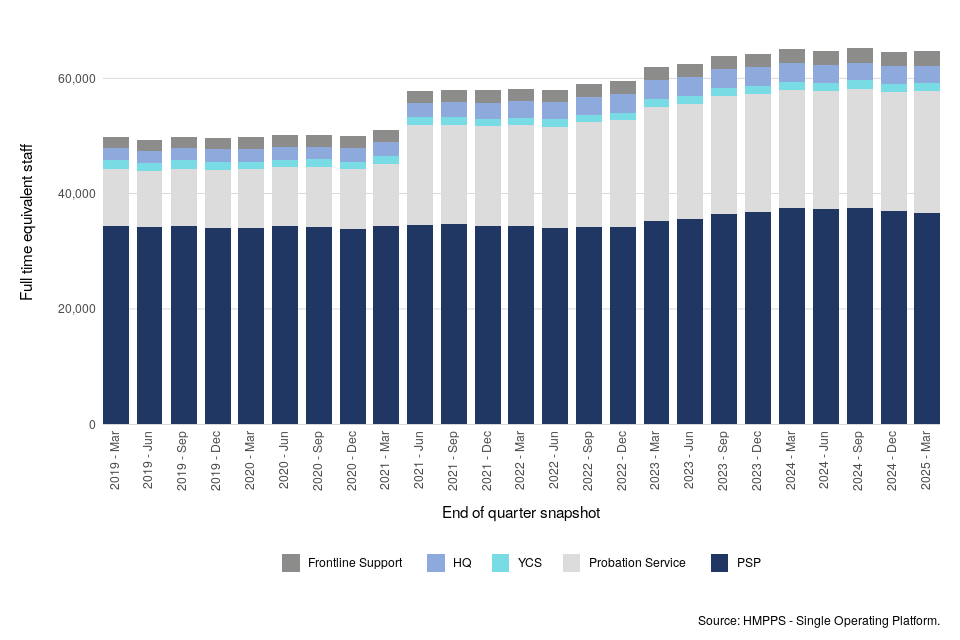
1.1 Length of Service
Across HMPPS overall, 33.3% of FTE staff in post had less than 3 years’ service, which was a decrease from 35.4% at 31 March 2024 and a slight decrease from 34.2% at 31 December 2024. 33.1% of HMPPS FTE staff in post had 10 years or more of experience, representing no substantial change since 31 December 2024.
The proportion of band 3-5 prison officers with less than 3 years’ service at 31 March 2025 fell to 37.5% compared to 41.5% as at 31 March 2024. The proportion of band 3-5 prison officers in post with 10 years or more of experience slightly decreased by 0.9 percentage points from 25.8% at 31 March 2024 to 24.9% at 31 March 2025. This corresponds to 5,668 FTE staff with 10 years or more of experience at 31 March 2025, which is a fall of 427 FTE, or 7.0% since 31 March 2024.
The proportion of band 2 OSG FTE staff with less than 3 years’ service decreased from 52.8% at 31 March 2024 to 49.6% at 31 March 2025, and the proportion of those with 10 years or more of experience decreased from 24.6% at 31 March 2024 to 23.4% at 31 March 2025.
It should be noted, that the National Probation Service was created on 1 June 2014 and service prior to this is not captured in our data. Therefore, the figures relating to the length of service of Probation Service staff, which are included in the HMPPS overall figures, do not necessarily represent their full experience but rather the length of service from entry to HMPPS. The situation is different for the over 7,000 staff who transferred from the CRCs in June 2021 and for them their service prior to their date of transfer is included.
Length of service information has been calculated for HMPPS staff from the most recent hire date. Where staff have transferred in from another government department or have transferred in through HMPPS taking over a function, length of service is calculated from entry to HMPPS.
2. Band 3-5 prison officers and band 2 operational support staff
22,737 FTE band 3-5 prison officers in post (as at 31 March 2025)
This is a decrease of 878 FTE (3.7%) since 31 March 2024 and a slight decrease of 325 FTE (1.4%) prison officers compared to 31 December 2024, though the change since last year would have been affected by introduction of 254 FTE prison officers in Lowdham Grange in August 2024. In the last year there has been a more targeted approach to prison officer recruitment in reaction to specific regional staffing requirements focusing on filling vacancies substantively.
5,424 FTE band 2 operational support staff in post (as at 31 March 2025)
This corresponds to a decrease of 118 FTE (2.1%)FTE since 31 March 2024 and a slight decrease of 85 FTE (1.5%) operational support staff since 31 December 2024.
The key operational grades in public sector prisons are the band 3 to 5 prison officers. They consist of band 3 prison officers, band 4 officer specialists, band 4 supervising officers, and band 5 custodial managers.
Figure 2: Number of band 3-5 prison officers in post on an FTE basis, 31 March 2019 to 31 March 2025 (Source: Table 3)
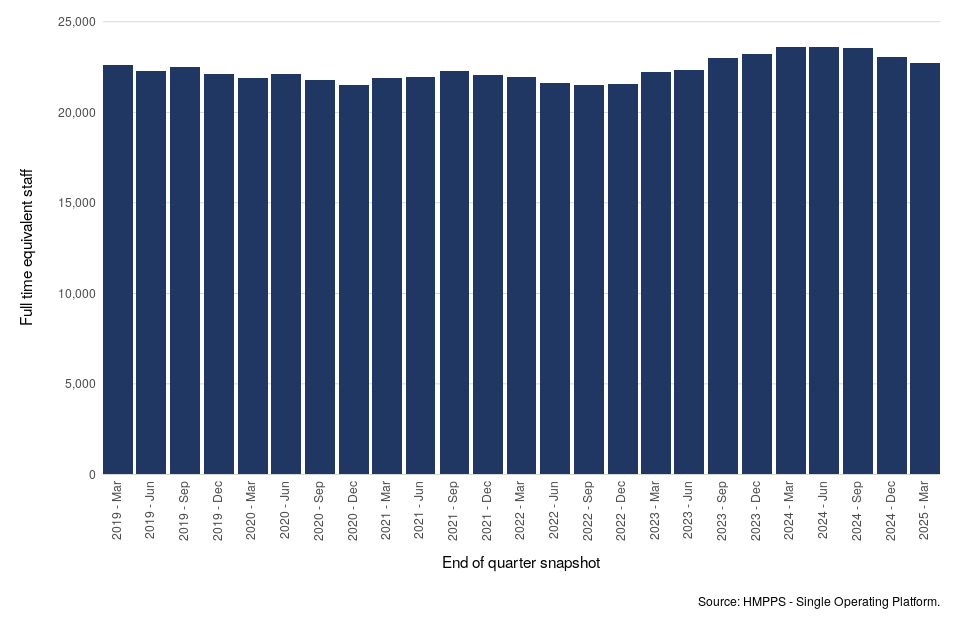
Figure 3 shows a quarterly trend of band 3 to 5 appointments and leavers since 2018/19. Over the year to 31 March 2025, 2,632 band 3 to 5 officers were appointed (consisting of direct new recruits and existing staff who converted to a band 3 officer grade), a decrease of 2,628 (50.0%) compared to 5,260 in the previous year. Looking at the quarterly figures, the headcount of new band 3 to 5 officer appointments increased by 163 (42.9%) from 380 between October and December 2024 to 543 between January and March 2025 (Table 17).
The headcount of band 3 to 5 prison officers who left HMPPS in the year ending 31 March 2025 was 2,985, which is a decrease of 185 (5.8%) compared to the year ending 31 March 2024. Examining reasons for leaving, 66.9% of prison officers who left in the year ending 31 March 2025 resigned from their roles (up from 64.5% in the year ending 31 March 2024). Of the other prison officers who left HMPPS in the year ending 31 March 2025, 20.2% were dismissed and 6.4% retired; the proportion dismissed is up from 17.6% compared to previous year while the number retiring is up from 5.4%. Following the staff survey in 2023 one of HMPPS’ priorities was to set a positive culture through high professional standards. Specialist teams have been established to ensure those standards are met and that interventions can be put in place where necessary.
Figure 3: Newly appointed band 3 to 5 prison officers and band 3 to 5 prison officer leavers, April 2018 to 31 March 2025 (Source: Table 17)
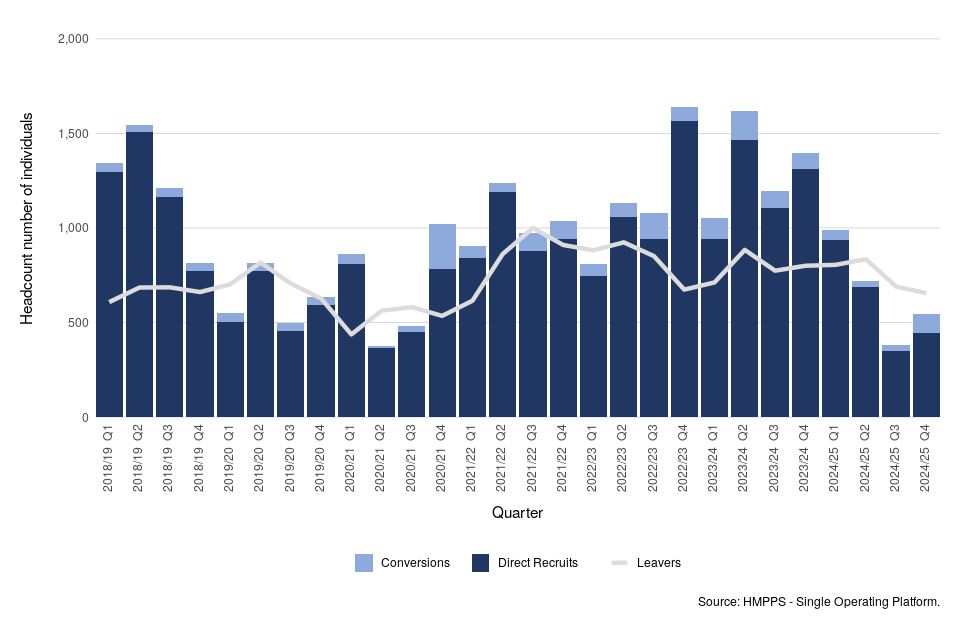
Joiners and leavers are not the only movements into and out of the band 3 to 5 officer grouping. There are also typically differences in the proportion of new joiners and older officers who work part time as well as movements between grades, such as internal movements to non-frontline roles or promotions to operational managers. Changes such as staff switching from full time to part time also have the effect of reducing the FTE of officers available as they progress through their career. For these reasons, the change in FTE does not directly reflect the difference between the number of joiners and leavers.
The number of band 2 OSG staff who joined HMPPS in the year ending 31 March 2025 was 973: a decrease of 795 (45.0%) compared to the previous year ending 31 March 2024. There was a decrease of 241 (19.9%) since the year ending 31 December 2024. The headcount number of band 2 OSG staff who left HMPPS was 862, which is a decrease of 80 (8.5%) compared to the year ending 31 March 2024 and a decrease of 75 (8.0%) compared to the year ending 31 December 2024.
3. Probation practitioners and senior probation officers
5,657 FTE band 4 probation officers in post (as at 31 March 2025)
This figure is an increase of 319 FTE (6.0%) since 31 March 2024 and an increase of 375 FTE (7.1%) probation officers compared to 31 December 2024. In addition to the band 4 probation officers, there were 5,253 FTE band 3 probation services officers: a decrease of 604 FTE (10.3%) since 31 March 2024 and a slight decrease of 63 FTE (1.2%) since 31 December 2024.
Key grades in the Probation Service include band 3 probation services officers, band 4 probation officers (collectively known as probation practitioners), as well as band 5 senior probation officers. Staff who are training to be a probation officer work as a probation services officer during their training, so a proportion of the probation services officers in post will be working towards the professional probation officer qualification.
In the June 2019 publication a statistics annex was added to this bulletin which presents figures on probation officers in post, their required staffing level, in addition to the number of trainee and qualified probation officers.
As at 31 March 2025, there were 5,253 FTE band 3 probation services officers in post, a decrease of 604 FTE (10.3%) over the past year and a slight decrease of 63 FTE (1.2%) over the quarter. For the 2025/26 financial year, the department has committed publicly to onboarding at least 1,300 Trainee Probation Officers and it will confirm whether it has met that commitment in the April 2026 transparency release. There were 5,657 FTE band 4 probation officers, representing an increase of 319 FTE (6.0%) over the past year and an increase of 375 FTE (7.1%) compared to the previous quarter; and 1,534 FTE band 5 senior probation officers, showing an increase of 41 (2.7%) over the previous year and a slight increase of 11 (0.7%) since the last quarter (Figure 4).
Figure 4: Number of probation officers, probation services officers and senior probation officers in post on an FTE basis, 31 March 2019 to 31 March 2025 (Source: Table 3)
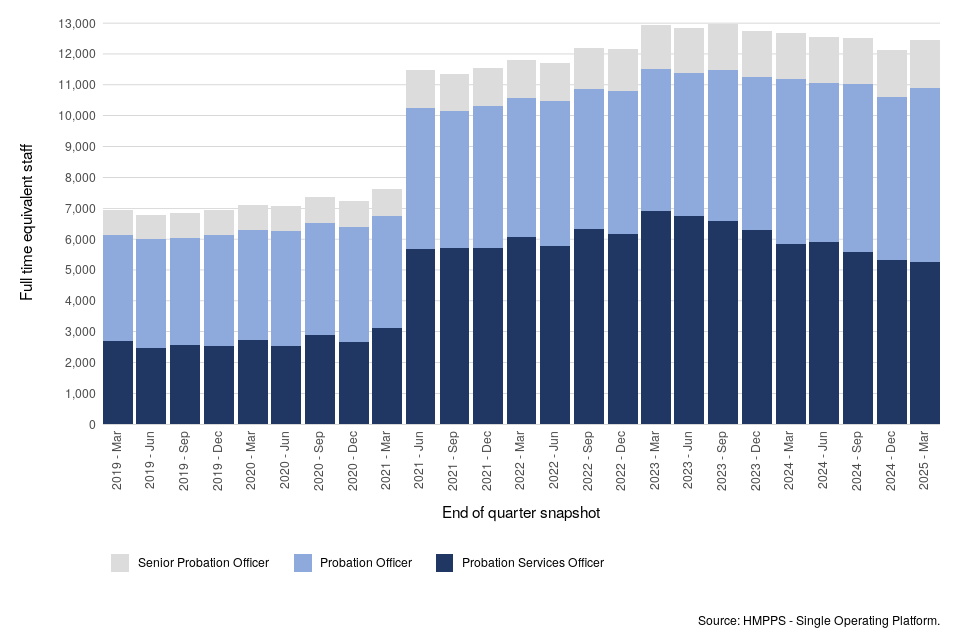
In the past year, 1,225 probation services officers were appointed, some of whom will be training to become qualified probation officers. This is an increase of 149 (13.8%) compared to the year ending 31 March 2024 and an increase of 274 (28.8%) compared to the number appointed in the year ending 31 December 2024.
Within the Probation Service, there were 5,636 FTE Probation Officers in post, a shortfall of 1,479 FTE against the target staffing level of 7,115 FTE. There were 1,483 staff, equivalent to 1,454 FTE, undertaking the PQiP training as of 31 March 2025. The shortfall in Probation Officers has decreased relative to the December release following recent PQiP trainee qualifiers (please refer to the Prison and Probation Officer Recruitment Annex for more details).
In the past year, 601 probation services officers left the service. This is a decrease of 252 (29.5%) compared to the year ending 31 March 2024, and of 93 (13.4%) compared to the number who left in the year ending 31 December 2024.
4. Joiners and Leavers
Leaving rate of 12.2% amongst band 3-5 prison officers (for the 12 months ending 31 March 2025)
This is a slight decrease of 1.0 percentage points compared to the year ending 31 March 2024. The overall leaving rate across HMPPS over the past year stood at 10.5%, which is a decrease of 1.1 percentage points compared to the year ending 31 March 2024 of 11.6%
Over the past year, 7,192 staff joined HMPPS, which is a decrease of 4,033 (35.9%) compared to the year ending 31 March 2024. In response to recruitment and retention challenges in certain parts of the country, in 2023 the department purposefully over-recruited at prisons with a strong track-record of recruitment, allowing staff to be temporarily deployed to other prisons. We have actively managed down the number of surplus staff at these sites, whilst substantively filling vacancies at the sites that required resourcing support.
The joiners consisted of 3,973 across PSP, 187 in the YCS, 2,787 in the Probation Service, and 245 in HMPPS HQ and Frontline Support. Compared to the year ending 31 March 2024, these numbers of joiners represent a decrease of 45.8% for PSP, a decrease of 46.4% for YCS, a decrease of 13.2% for Probation Service, and a decrease of 27.3% for HMPPS HQ and Frontline Support. There were 1,057 Trainee Probation Officers starting PQiP training in the Probation Service in 2024/25, compared to 543 in 2023/24.
There were 7,414 leavers in the year ending 31 March 2025, a decrease of 833 (10.1%) compared to the year ending 31 March 2024. This includes 4,667 leavers from PSP (a decrease of 5.3%), 223 from YCS (no substantial change), 2,146 from the Probation Service (a decrease of 10.6%), and 378 from HMPPS HQ and Frontline Support (a decrease of 45.6%).
4.1 Leaving Rates[footnote 2]
The overall HMPPS leaving rate for the year to 31 March 2025 was 10.5% compared to 11.6% for the year to 31 March 2024 (Figure 5); a decrease of 1.1 percentage points. For the year up to 31 March 2021, the increased uncertainty in the employment market following the COVID-19 pandemic may have contributed to the drop in the number of resignations during most of the year, therefore impacting on the overall reduced leaving and resignation rates. Although the latest leaving rates for most grades are still higher than pre-pandemic levels, most have shown a decrease over the last 24 months.
The leaving rate for staff at the Probation Service overall in the year ending 31 March 2025 was 9.3%, which is a decrease of 1.2 percentage points since the year ending 31 March 2024. In the operational grades within the Probation Service, the leaving rate was highest amongst probation services officers at 10.0%: a decrease of 2.3 percentage points from the year ending 31 March 2024. Leaving rates for probation officers and senior probation officers stood at 7.0% (a decrease of 1.0 percentage point) and 4.4% (an increase of 0.2 percentage points), respectively, compared to the year to 31 March 2024.
Figure 5: Annual leaving rates of permanent staff in key operational grades (excluding VEDSR), from the 12 months to 31 March 2019 to the 12 months to 31 March 2025 (Source: Table 11)
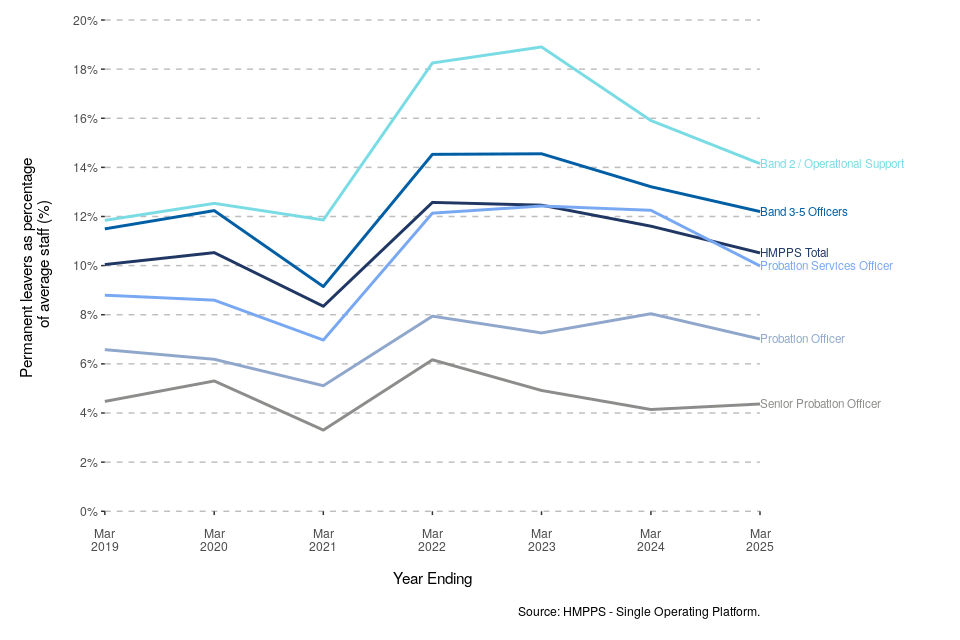
4.2 Resignation Rates[footnote 3]
The overall HMPPS resignation rate for the 12 months to 31 March 2025 was 6.6%, compared to 7.2% for the year to 31 March 2024 (Figure 6). For band 3-5 officers, the resignation rate was 8.2% in the year ending 31 March 2025, which is a decrease of 0.4 percentage points since the year ending 31 March 2024. The resignation rate for OSG staff was 9.6% for the year ending 31 March 2025, which is a decrease of 1.4 percentage points since the year ending 31 March 2024.
For the Probation Service the resignation rate was 6.0% for the year ending 31 March 2025. This represents a decrease of 0.9 percentage points compared to the year ending 31 March 2024. Amongst the operational grades within the Probation Service, probation services officers had the highest resignation rate at 7.2%, a decrease of 1.5 percentage points since the year ending 31 March 2024.
Figure 6: Annual resignation rates of permanent staff in key operational grades, from the 12 months to 31 March 2019 to the 12 months to 31 March 2025 (Source: Table 12)
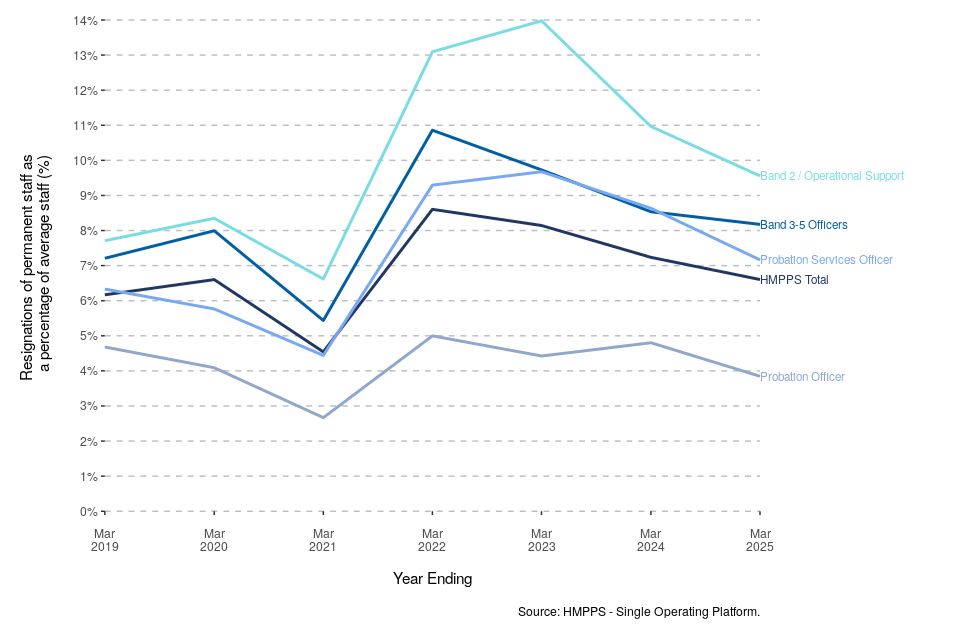
5. Sickness absence
HMPPS staff lost an average of 11.9 working days to sickness absence in the 12 months ending 31 March 2025
This represents an increase of 0.8 Average Working Days Lost (AWDL) compared to the year ending 31 March 2024 (11.1 working days lost).
In the year ending 31 March 2025, HMPPS staff lost an average of 11.9 working days to sickness absence. This is an increase from 11.1 average working days lost for the year ending 31 March 2024, and an increase of 1.6 days compared to the predominantly COVID-19 free year ending 31 March 2020.
YCS staff had the highest sickness absence rate at 17.7 AWDL, followed by the Probation Service (13.3 AWDL), PSP (11.7 AWDL), and HQ and Frontline Support (6.6 AWDL) (Figure 7). Compared to the year ending 31 March 2024, these represent an increase of 0.7 days for YCS, an increase of 0.7 days for Probation Service, an increase of 0.8 days for PSP, and an increase of 0.6 days for HQ and Frontline Support staff.
Figure 7: Average working days lost to sickness absence, 12 months to 31 March 2019 to 12 months to 31 March 2025 (Source: Table 18)

The most common category of sickness absence in terms of days lost was mental ill health, corresponding to 40.3% of working days lost in the past year. This category was most prevalent for probation officers, where 57.5% of working days lost were attributed to mental ill health.
For HMPPS overall the category that accounted for the second largest proportion of working days lost was musculoskeletal system (18.2%). Together the top two categories accounted for 58.5% of all working days lost.
6. Equality and Diversity
Data on the protected characteristics of ethnicity, disability, sexual orientation, and religion/belief are collected from self-declared, non-compulsory fields. Consequently, only figures for which declaration rates have reached a threshold of 60% or above have been reported in the following section. Representation rates show the percentage within a specified category out of all those who have declared (i.e. excluding those who have not responded or those who have indicated they do not wish to declare).
For staff in post as at 31 March 2025 the main representation rates were as follows; 55.0% of staff were female, 16.1% were from ethnic minority backgrounds, 17.6% disabled, 7.9% were Lesbian, Gay, Bisexual and Other (LGBO) and 9.4% were non-Christian.
For new staff joining in the 12 months to 31 March 2025 the main representation rates were as follows; 52.9% of staff were female, 37.4% were from ethnic minority backgrounds, 11.4% disabled, 9.4% were LGBO and 12.7% were non-Christian.
For staff leaving in the 12 months to 31 March 2025 the main representation rates were as follows; 50.1% of staff were female, 18.0% were from ethnic minority backgrounds, 18.9% disabled, 8.0% were LGBO and 11.0% were non-Christian.
6.1 Age
The largest individual age group across all of HMPPS at 31 March 2025 was 30-39 year olds with 17,981 staff (26.1%). The number of staff aged under 30 decreased by 794 in the 12 months to 31 March 2025 compared to the previous year and made up 20.1% of the HMPPS workforce. HQ and Frontline Support had the oldest workforce, consisting of 59.4% of staff who were aged 40 or over. This is compared to 53.9% among Probation Service staff, 53.2% among PSP staff, and 45.0% among YCS staff. Those aged under 30 make up the highest proportion of joiners (43.7%) overall, and those aged under 30 make up the highest proportion of leavers (27.9%) overall.
Figure 8: Age of HMPPS staff, as at 31 March 2025 (Source: Table 5)
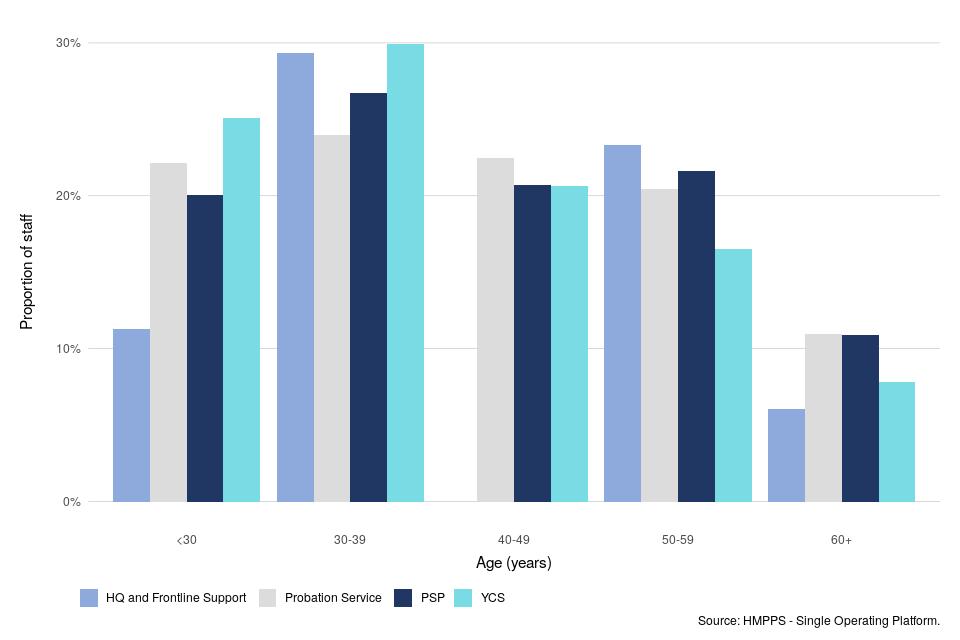
6.2 Gender
As at 31 March 2025, 55.0% of HMPPS staff overall were female, which is no substantial change compared to the previous year. Female representation was highest within the Probation Service at 75.6%, compared to 65.5% in HQ and Frontline Support, 47.2% in the YCS, and 41.7% in PSP. Across all of HMPPS, over the 12 months to 31 March 2025, 52.9% of joiners and 50.1% of leavers were female.
Figure 9: Gender of HMPPS staff, as at 31 March 2025 (Source: Table 5)
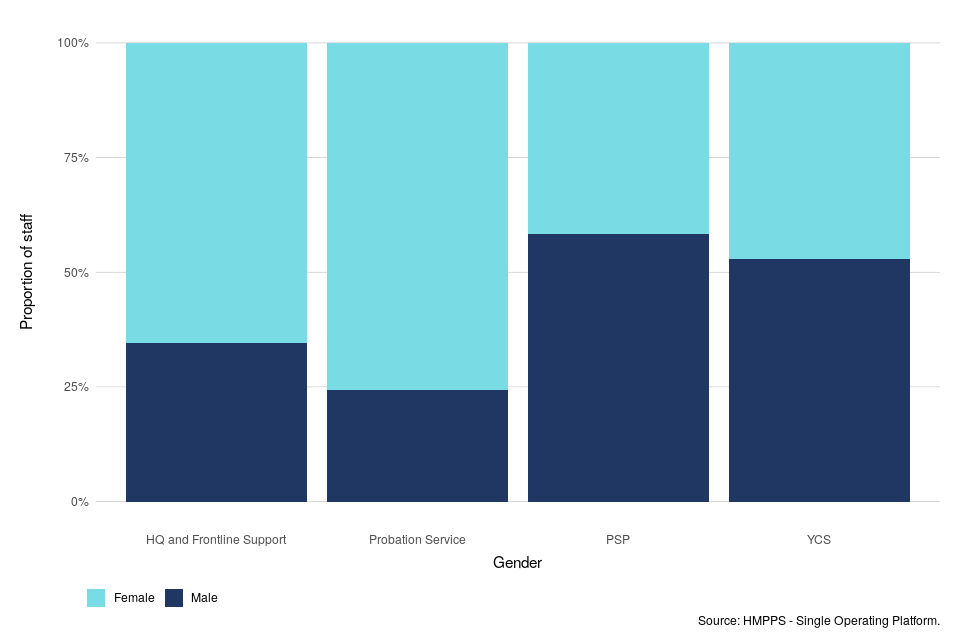
6.3 Full time/part time status
Full time/part time is a status that may fluctuate across an individual’s career. Part time as a grouping covers a wide range of working patterns and working hours. Within HMPPS overall, 15.1% of the workforce were identified as working part time, representing a slight increase of 0.5 percentage points compared to the previous year. Working on a part time basis is more common amongst staff in the Probation Service. As at 31 March 2025, 20.3% of Probation Service staff were working part time, compared to 13.2% of staff in PSP,9.6% of staff in YCS, and 8.6% of staff in HQ and Frontline Support.
Only 8.5% of joiners worked on a part time basis, which is to be expected given this period usually marks the start of an individual’s career, whilst 20.2% of leavers were recognised as having part time status.
Figure 10: Working pattern of HMPPS staff, as at 31 March 2025 (Source: Table 5)
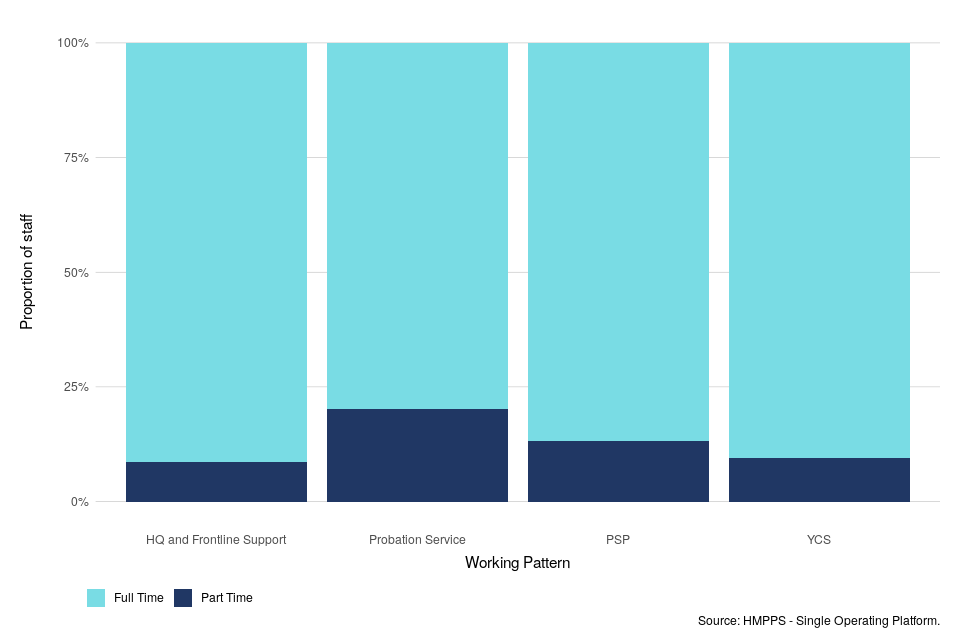
6.4 Ethnicity
As at 31 March 2025, 16.1% of HMPPS staff who had declared their ethnicity were from ethnic minority backgrounds, which is a slight increase of 1.9 percentage points compared to the previous year. HQ and Frontline Support had the lowest representation rate with 13.6% of staff who declared their ethnicity being ethnic minority (no substantial change since 31 March 2024), compared to 14.6% of staff in PSP (an increase of 2.7 percentage points since 31 March 2024), 18.9% of staff in Probation Service (a slight increase of 0.9 percentage points since 31 March 2024), and 26.5% of staff in YCS (an increase of 3.9 percentage points since 31 March 2024).
In the 12 months to 31 March 2025, 18.0% of leavers across all of HMPPS who had declared their ethnicity were from ethnic minority backgrounds.
Figure 11: Ethnicity of HMPPS staff, as at 31 March 2025 (Source: Table 5)
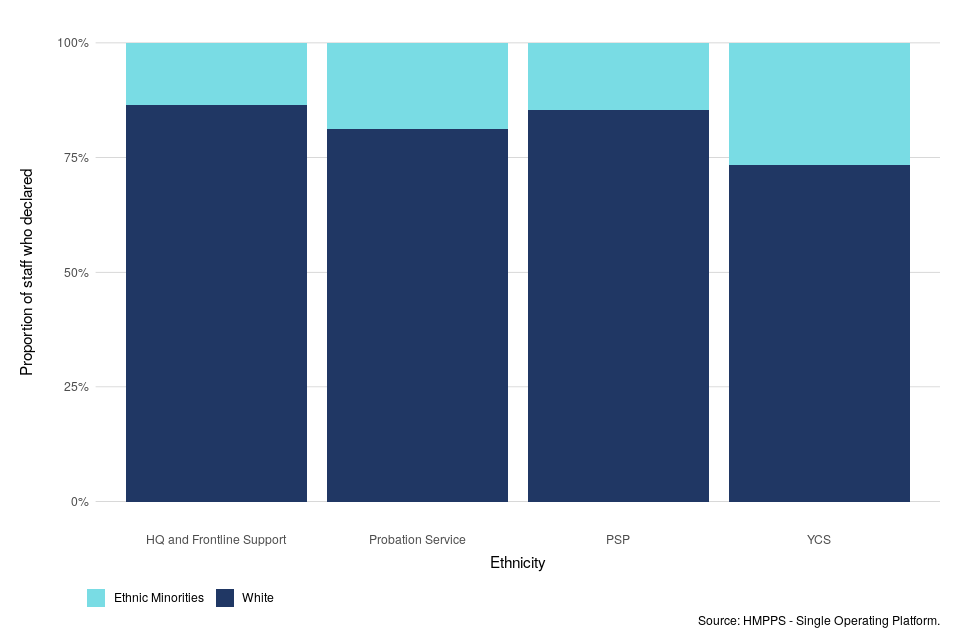
6.5 Other Protected Characteristics
As at 31 March 2025, 17.6% of HMPPS staff who had declared their disability status were disabled. PSP had the lowest representation rate with 13.6% of staff who declared their disability status being disabled, compared to 13.7% of staff in YCS, 17.3% of staff in HQ and Frontline Support, and 24.7% of staff in Probation Service. In the 12 months to 31 March 2025, 11.4% of joiners and 18.9% of leavers across all of HMPPS who had declared their disability status were disabled.
As at 31 March 2025, Lesbian, Gay, Bisexual and Other (LGBO) staff represented 7.9% of HMPPS staff who had declared their sexual orientation. HQ and Frontline Support had the lowest representation rate with 7.2% of staff who declared their sexual orientation identifying as LGBO, compared to 7.9% of staff in PSP, 8.3% of staff in Probation Service, and 8.4% of staff in YCS. In the 12 months to 31 March 2025, 9.4% of joiners and 8% of leavers across all of HMPPS who had declared their sexual orientation were LGBO.
As at 31 March 2025, 9.4% of HMPPS staff who had declared their religion or belief followed another (non-Christian) religion. PSP had the lowest representation rate with 8.1% of staff following a non-Christian eligion, compared to 9.0% of staff in HQ and Frontline Support, 11.4% of staff in Probation Service, and 13.7% of staff in YCS. In the 12 months to 31 March 2025,12.7% of joiners and 11% of leavers across all of HMPPS who had declared their religion were non-Christian.
No data are currently presented or available for the other protected characteristics of Marriage and Civil Partnership, Pregnancy and Maternity.
Data are not collected for Gender Reassignment as those in receipt of gender recognition certificates are recorded as their legal gender, and are not identified as being transgender in accordance with the Gender Recognition Act 2004 and the Equality Act 2010.
Further Information
Accompanying files
As well as this bulletin, the following products are published as part of this release:
-
A technical guide providing details of the HMPPS workforce structure as well as how the data are collected and processed. Information on the revisions policy and disclosure relevant to HMPPS staffing data is also included.
-
A supplementary annex presenting statistics on the staff recruited as part of the ‘Great Place to Work for Veterans’ recruitment campaign.
-
A supplementary annex presenting statistics on probation officers in post, their required staffing level, and the number of trainee and qualified probation officers. In addition, it includes published quarterly hours adjusted Staff in Post, Target Staffing and Difference at establishment level for Band 3-5 Prison Officers.
Accredited Official Statistics
The statistics in this bulletin are classified as accredited official statistics. Accredited official statistics refer to official statistics that have been independently reviewed by The Office for Statistics Regulation (OSR) to ensure they comply with the standards trustworthiness, quality and value in the Code of Practice for Statistics. Accredited official statistics are referred to as ‘National Statistics’ in the Statistics and Registration Service Act 2007. The term ‘Accredited Official Statistics’ to describe national statistics was introduced by OSR in September 2023, following a review of the National Statistics designation.
The Statistics and Registration Service Act 2007 defines ‘official statistics’ as all those statistical outputs produced by the UK Statistics Authority’s executive office (the Office for National Statistics), by central Government departments and agencies, by the devolved administrations in Northern Ireland, Scotland, and Wales, and by other Crown bodies (over 200 bodies in total). The statistics in this bulletin comply with all aspects of the Code of Practice for Official Statistics. The Code encourages and supports producers of statistics to maintain their independence and to ensure adequate resourcing for statistical production. It helps producers and users of statistics by setting out the necessary principles and practices to produce statistics that are trustworthy, high quality and of public value.
Accredited Official Statistics in development
Accredited official statistics in development are a subset of newly developed or innovative official statistics undergoing evaluation. They are developed under the guidance of the Head of Profession for Statistics (HoP) and published to involve users and stakeholders in the assessment of their suitability and quality at an early stage. Therefore, we would like to receive feedback as to how useful they are, whether a different analysis would be preferable, or any other comments about them. If you wish to send any views you may have about these accredited official statistics in development, please use the contact details below.
Contact
Press enquiries should be directed to the Ministry of Justice press office:
https://www.gov.uk/government/organisations/ministry-of-justice/about/media-enquiries
Other enquiries about these statistics should be directed to:
Rob Hartley
Workforce Statistics & Analysis
Analysis Directorate
Ministry of Justice
10 South Colonnade
London
E14 4PH
Email: robert.hartley@justice.gov.uk
Next update: 21 August 2025
URL: www.gov.uk/government/collections/national-offender-management-service-workforce-statistics
© Crown copyright
Produced by the Ministry of Justice
Alternative formats are available on request from robert.hartley@justice.gov.uk
-
This includes staff in Probation Service grades working in other parts of HMPPS. ↩
-
Percentage of staff with a permanent contract of employment who left HMPPS, including individuals who have retired early, but excluding staff who left due to voluntary early departure schemes and redundancy (VEDSR). ↩
-
Percentage of staff with a permanent contract of employment who resigned from HMPPS. ↩
